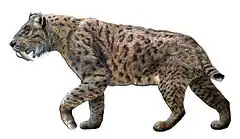| Hemimachairodus Temporal range: | |
|---|---|
| Scientific classification | |
| Domain: | Eukaryota |
| Kingdom: | Animalia |
| Phylum: | Chordata |
| Class: | Mammalia |
| Order: | Carnivora |
| Suborder: | Feliformia |
| Family: | Felidae |
| Subfamily: | †Machairodontinae |
| Genus: | †Hemimachairodus Koenigswald, 1974 |
| Type species | |
| Hemimachairodus zwierzyckii (von Koenigswald, 1934) | |
| Synonyms | |
| |
Hemimachairodus is an extinct genus of machairodontine (sabre-toothed) cat with only one species, Hemimachairodus zwierzyckii, known from fossils from the Pleistocene of Java.
Fossil segments of Hemimachairodus were unearthed in Pleistocene dig sites in Java in Indonesia alongside other predators such as Panthera tigris, Homotherium ultimum, and Megacyon merriami, and it most likely competed with these species for prey. H. zwierzyckii was estimated by one study to have weighed about 130 kilograms (290 lb).[1]
Discovery and naming
The species was originally described in 1934 by German palaeontologist Gustav Heinrich Ralph von Koenigswald under the name Epimachairodus zwierzyckii.[2] He referred to it again by that name in 1940.[3] A 1962 study by Bjorn Kurtén referred to it as Homotherium zwierzyckii but stated that it was certainly not a member of Homotherium and instead recommended assigning it to the genus Megantereon.[4]
In 1974, Koenigswald described more fossils that he assigned to the species, and named the new genus Hemimachairodus.[5]
The specific epithet was given in honor of the Polish geologist Józef Zwierzycki.[6]
Description
Koenigswald's 1974 diagnosis of Hemimachairodus noted the complete reduction of the third premolar, and serrations on the upper canine teeth being limited to the inner edge.[5]
The holotype of Hemimachairodus zwierzyckii is a partial left mandibular ramus, retaining the first incisor, the canine, and the fourth premolar, after which it is broken. Koenigswald in 1974 described it as having a weak mental process and a strongly developed mental crest. The mandible itself is slender, with a 46mm diastemata. It was recovered from Sangiran in central Java.[5]
From Sangiran, Koenigswald (1974) also described a second partial jaw fossil, broken about 1cm behind the molar and 2cm in front of the premolar and retaining both teeth; one tip and one complete lower canine; and two fragments of an upper canine tooth. And from the Djetis Beds Modjokerto in eastern Java, a fragment of a mandible retaining a premolar and the front half of a molar.[5]
References
- ↑ Volmer, Rebekka; Hertler, Christine; van der Geer, Alexandra (1 January 2016). "Niche overlap and competition potential among tigers (Panthera tigris), sabertoothed cats (Homotherium ultimum, Hemimachairodus zwierzyckii) and Merriam's Dog (Megacyon merriami) in the Pleistocene of Java". Palaeogeography, Palaeoclimatology, Palaeoecology. 441: 901–911. Bibcode:2016PPP...441..901V. doi:10.1016/j.palaeo.2015.10.039. hdl:10795/3286.
- ↑ von Koenigswald, G. H. R. (1934). "Zur Stratigraphie des javanischen Pleistocan" [On the stratigraphy of the Javanese Pleistocene]. De Ingenieur in Nederlandsch Indie (in German). 1 (11): 190. hdl:1887.1/item:2451806.
- ↑ von Koenigswald, D. H. R. (1940). "Neue Pithecanthropus-Funde 1936-1938; Eine Beitrag zur Kenntnis der Prae-Hominiden". Wetenschapplijke Mededeelingen Dienst van Mijnbouw NederlandscheIndië. 28: 57.
- ↑ Kurtén, B. (1962). "The sabre-toothed cat Megantereon from the Pleistocene of Java". Zoologische Mededelingen. 38 (6): 101–104.
- 1 2 3 4 von Koenigswald, G.H.R. (1974). "Fossil mammals of Java part 6: Machairodontinae from the lower Pleistocene of Java". Proceedings of the Koninklijke Nederlandse Akademie van Wetenschappen Series B Physical Sciences. 77 (4): 267–273. INIST PASCALGEODEBRGM7520066100.
- ↑ Chrząstek, Alina; Górecka-Nowak, Anna; Kryza, Ryszard (2014). "Józef Zwierzycki, a great geologist of the 20th century (reminiscence 50 year after decease)". Geologia Sudetica. 42 (3–189): 172.
